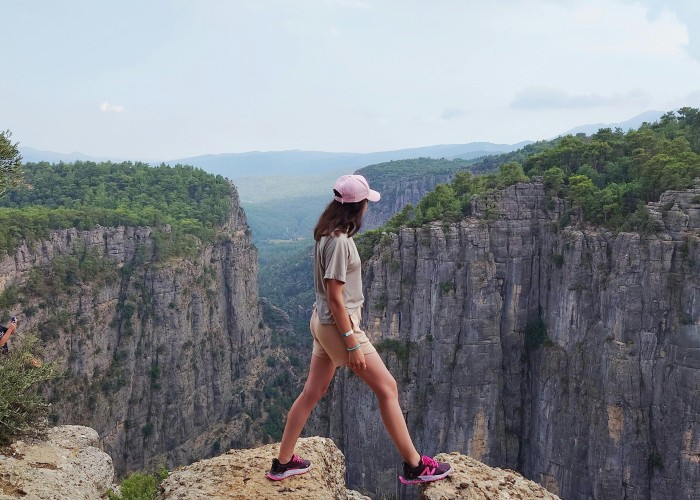Few places in the American Southwest carry the same sense of wonder and cultural depth as Canyon de Chelly National Monument in northeastern Arizona. Known for its dramatic sandstone cliffs, towering spires, and centuries-old cliff dwellings, the canyon is not only a natural marvel but also a living cultural landscape. Canyon de Chelly Horseback Tour.
One of the most authentic ways to explore this site is through a horseback tour. Riding along sandy canyon floors and past ancient ruins allows visitors to connect with the land in a slower, more traditional way. The tours are often led by local Navajo guides, who share stories about their history, traditions, and ties to the land. For travelers who enjoy outdoor adventures with cultural depth, a horseback trek through Canyon de Chelly is truly unforgettable.
Overview
- Location: Northeastern Arizona, near the town of Chinle, within the Navajo Nation
- Why It’s Famous: Red sandstone cliffs, Spider Rock (an 800-foot spire), ancient Ancestral Puebloan cliff dwellings, and Navajo cultural heritage
- Tour Experience: Horseback rides through canyons with views of petroglyphs, ruins, orchards, and sweeping desert landscapes
Canyon de Chelly stands apart from many U.S. parks because it remains inhabited. Families still farm and live in the canyon, making it a rare blend of living culture and historic preservation.
Best Time to Visit
- Spring (March to May): Comfortable temperatures and blooming desert plants make it one of the best seasons for horseback tours.
- Summer (June to August): Very hot, with afternoon thunderstorms common. Tours often run in the morning or late afternoon to avoid peak heat.
- Fall (September to October): Mild weather and fewer crowds make this another excellent time.
- Winter (November to February): Quiet, with colder mornings and possible snow, but tours may still be available depending on conditions.
Most visitors prefer spring and fall, when the weather is pleasant for outdoor riding and hiking.
How to Reach
- By Air: The closest airports are in Gallup, New Mexico (about 90 miles away), and Flagstaff, Arizona (about 180 miles away). Larger airports such as Albuquerque and Phoenix are several hours away by car.
- By Road: Canyon de Chelly is accessible via U.S. Highway 191 to the town of Chinle. From there, guided tours and horseback rides typically begin.
- By Train/Bus: There are no direct train routes to Chinle. Some regional bus services reach nearby towns, but renting a car is the most practical option.
Entry Fees and Permits
- Park Entrance: Canyon de Chelly National Monument does not charge a general entrance fee.
- Guided Tours: Horseback tours are typically arranged with Navajo guides, and costs vary depending on duration (half-day or full-day rides). Prices are approximate and subject to change.
- Permits: Independent exploration of the canyon floor is not allowed. A local guide is required for horseback and jeep tours.
Food Availability and Meal Options
- Inside the Monument: There are no full-service restaurants within the canyon. Visitors should bring water and snacks.
- Nearby Towns: Chinle offers small restaurants, cafes, and grocery stores.
- During Tours: Riders are usually advised to bring a packed lunch, especially for longer horseback treks.
Water is essential—carry enough for the entire day, as desert conditions can cause dehydration quickly. Canyon de Chelly Horseback Tour.
Packing List and Essentials
When preparing for a horseback tour in Canyon de Chelly, pack light but smart. Essentials include:
- Comfortable clothing suitable for horseback riding
- Sturdy boots or closed-toe shoes
- Wide-brimmed hat and sunglasses for sun protection
- Lightweight jacket or layer (temperatures can vary)
- At least 2 liters of water per person
- Snacks or packed meal for longer rides
- Sunscreen and lip balm
- Camera or phone for photography (ask before photographing cultural sites)
- Small backpack or saddlebag for personal items
Safety Tips and Local Regulations
- Hydrate constantly: Desert air can cause dehydration faster than expected.
- Respect guide instructions: Horseback tours are led by Navajo guides who know the land and its risks.
- Watch for weather changes: Flash floods can occur in narrow sections of the canyon.
- Stay with your group: Independent exploration is not allowed for safety and cultural protection.
- Respect sacred sites: Many ruins and rock art locations are culturally sensitive and must not be touched or disturbed.
Tips for Beginners or First-Time Visitors
- If you’ve never ridden a horse before, don’t worry—guides provide instruction and match riders with calm, well-trained horses.
- Start with a half-day ride if you’re unsure about endurance.
- Wear long pants to avoid saddle rubs.
- Stretch before and after riding to reduce muscle stiffness.
- Keep valuables secure, as bumpy rides can cause items to fall.
Local Customs or Cultural Etiquette
Canyon de Chelly lies within the Navajo Nation, and respecting local customs is essential.
- Always ask permission before photographing people.
- Avoid entering private farmlands or homes without invitation.
- Listen respectfully when guides share stories about Navajo traditions and history.
- Do not remove artifacts, rocks, or plants from the canyon.
Showing respect for cultural traditions ensures a more meaningful experience and supports local communities.
Frequently Asked Questions (FAQs)
1. How long do horseback tours last?
They range from short 2-hour rides to full-day treks, depending on the package chosen.
2. Do I need prior horseback riding experience?
No. Tours are beginner-friendly, and guides provide instruction for first-time riders.
3. What is the difficulty level?
Moderate. While riding does not require hiking endurance, sitting for long hours on horseback can be tiring.
4. What is the elevation of Canyon de Chelly?
The canyon floor averages around 5,500 feet above sea level.
5. Are restrooms available during tours?
Restrooms are located at the visitor center and trailheads, but not along the canyon floor routes.
6. Is camping allowed inside the canyon?
Overnight stays in the canyon typically require special permits and a Navajo guide. Most visitors stay in lodges or campgrounds in Chinle.
7. Can children join horseback tours?
Yes, older children can participate, but age and size requirements may vary by tour provider. Canyon de Chelly Horseback Tour.
8. Is photography allowed?
Yes, but always ask before photographing people or sacred sites.
9. What makes Canyon de Chelly unique compared to other parks?
It is both a national monument and a living community, blending natural beauty with Navajo culture and history.
10. What is Spider Rock and why is it important?
Spider Rock is an 800-foot sandstone spire, central to Navajo legends and one of the canyon’s most iconic landmarks.
Conclusion
Exploring Canyon de Chelly on horseback is more than just a trek through Arizona’s red rock landscapes. It is an immersive experience that combines breathtaking scenery with centuries of human history and living Navajo culture. The gentle pace of a horse allows riders to absorb the canyon’s beauty in a way that cars or quick hikes cannot match. Canyon de Chelly Horseback Tour.






Leave a Reply